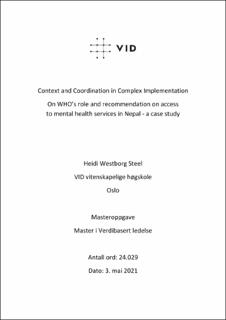| dc.description.abstract | Mental health has been a neglected subject globally, despite the fact that 1 billion people live with mental disorders, that a treatment gap exists where ¾ of people in need do not have access to mental health services, and that a suicide is committed every 4 seconds. The Nepali health ministry and WHO have increased their involvement only after the 2015 earthquake. Sub-cluster meetings were then initiated as a regular mechanism for interaction within the mental health care community in Nepal.
This inductive case study was conducted based on interviews with nine informants from the mental health care community in Nepal and from WHO. Its overarching theme has been how to implement a mental health care system in a low-resourced country. As this has been the part of WHO’s mission, the research question of this qualitative study is: “How is WHO’s role and recommendations on access to mental health perceived by main actors in Nepal?”.
From the findings, a model (see fig. 4) emerged, showing implementation of a mental health care system in Nepal as a ‘complex’ system of implementation. The perception is that WHO and their recommendations have played an important role on both a ‘policy’ level and a ‘program’ level, but also as a facilitator for ‘coordination’, including a wider range of mental health ‘entrepreneurial’ and ‘project’ initiatives in Nepal. The study discusses, with reference to implementation science, how this coordination and interaction has contributed to both the specific contextualization process of WHO tools and recommendations towards national ‘programs’, but also how the continued technical discussions taking place contribute to contextualisation on all levels, ensuring further quality assurance.
Based on discussions in Nilsen and Birken (2020) about ‘context’ and ‘complexity’ in implementation science, the study suggests to include perspectives from ‘translation theory’ from Rørvik (2016) and ‘values work’ from Gehman (2013) and the concept of ‘samhandling’ instead of ‘coordination’ (Torgersen, 2019) into the categorization by Nilsen (2015) of theories, models, and frameworks in implementation science. The discussion indicates that these additions would increase the understanding of context identified as a shortcoming in implementation science. | en_US |
